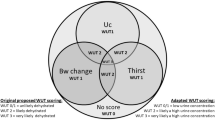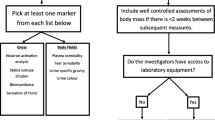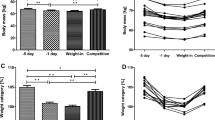Abstract
Purpose
Athletes in Olympic combat sports experience body water fluctuations resulting from training and intentional dehydration when making weight. Despite the popularity of urine specific gravity (USG) and urine osmolality (UOSM) measurement in characterizing fluid fluctuations, their utility remains questioned. This systematic review/meta-analysis examined the utility of urinary hydration indices in laboratory and field settings in Olympic combat sport athletes.
Methods
27 articles met the inclusion criteria for systematic review, 15 studies were included in the meta-analysis; with USG and UOSM the main outcome variables. Meta-regression analyses evaluated the interrelationship among body mass (BM), fluid intake, and urine measures.
Results
Significant USG alterations were observed following different sampling time frames: dehydration (ES 0.59; 95% CI 0.46–0.72; p = 0.001), follow-up period (ES 0.31; 95% CI 0.11–0.50; p = 0.002) and rehydration (ES − 0.34; 95% CI − 0.56 to − 0.12; p = 0.003). Direct comparison of laboratory (ES 0.20; 95% CI − 0.19 to 0.59; p = 0.324) and field (ES 0.35; 95% CI 0.14–0.56; p = 0.001) sampling showed marginally trivial and small effects. Small effects on UOSM were observed following dehydration (ES 0.31; 95% CI 0.12–0.74, p = 0.15), follow-up period (ES 0.39; 95% CI 0.08–0.70, p = 0.015) and rehydration (ES − 0.45; 95% CI − 0.60 to 0.30, p = 0.001). Meta-regression analysis suggests only fluid intake predicts USG alterations (p = 0.044) during rehydration protocols.
Conclusions
There were likely small changes in both USG and UOSM readings across all experimental conditions, with moderate-to-large heterogeneity in all studies, except for USG readings during dehydration protocols. The meta-regression failed to provide conclusive evidence concerning the interrelationship among urine measures, BM fluctuations, and fluid intake.




Similar content being viewed by others
References
Armstrong LE (2007) Assessing hydration status: the elusive gold standard. J Am Coll Nutr 26(sup5):575S–575S84S
Sawka MN, Burke LM, Eichner ER, Maughan RJ, Montain SJ, Stachenfeld NS (2007) Exercise and fluid replacement. Med Sci Sports Exerc 39(2):377–390. https://doi.org/10.1249/mss.0b013e31802ca597
Cheuvront SN, Kenefick RW (2014) Dehydration: physiology, assessment, and performance effects. Compr Physiol 4(1):257–285
Guyton AC, Hall JE (2006) Textbook of medical physiology. Elsevier, Philadelphia
Zubac D, Reale R, Karnincic H, Sivric A, Jelaska I (2018) Urine specific gravity as an indicator of dehydration in Olympic combat sport athletes; considerations for research and practice. Eur J Sport Sci 18(7):920–929
Reale R, Cox GR, Slater G, Burke LM (2016) Regain in body mass after weigh-in is linked to success in real life judo competition. Int J Sport Nutr Exerc Metab 26(6):525–530
Reale R, Slater G, Burke LM (2017) Individualized dietary strategies for Olympic combat sports: acute weight loss, recovery and competition nutrition. Eur J Sport Sci 17(6):1–14
Franchini E, Brito CJ, Artioli GG (2012) Weight loss in combat sports: physiological, psychological and performance effects. J Int Soc Sports Nutr 9(1):52–59
Pettersson S, Berg CM (2014) Hydration status in elite wrestlers, judokas, boxers, and taekwondo athletes on competition day. Int J Sport Nutr Exerc Metab 24(3):267–275. https://doi.org/10.1123/ijsnem.2013-0100
Loenneke JP, Wilson JM, Barnes JT, Pujol TJ (2011) Validity of the current NCAA minimum weight protocol: a brief review. Ann Nutr Metab 58(3):245–249
Oppliger RA, Steen SA, Scott JR (2003) Weight loss practices of college wrestlers. Int J Sport Nutr Exerc Metab 13(1):29–46
Nuccio RP, Barnes KA, Carter JM, Baker LB (2017) Fluid balance in team sport athletes and the effect of hypohydration on cognitive, technical, and physical performance. Sports Med 47(10):1951–1982
Arnaoutis G, Verginadis P, Seal AD, Vogiatzis I, Sidossis LS, Kavouras S (2018) Progressive dehydration in junior laser class sailors during world. Int J Sport Nutr Exerc Metab 28(1):75–81. https://doi.org/10.1123/ijsnem.2017-0142. (epub 2018 Jan 19)
Wilson G, Hawken MB, Poole I, Sparks A, Bennett S, Drust B, Morton J, Close GL (2014) Rapid weight-loss impairs simulated riding performance and strength in jockeys: implications for making-weight. J Sports Sci 32(4):383–391
Love TD, Baker DF, Healey P, Black KE (2018) Measured and perceived indices of fluid balance in professional athletes. The use and impact of hydration assessment strategies. Eur J Sport Sci 18(3):349–356
Zubac D, Antelj T, Olujic D, Ivančev V, Morrison SA (2017) Fluid balance and hydration assessment during the weight-stable preparation phase in elite youth boxers. J Sports Sci 35(8):719–726. https://doi.org/10.1080/02640414.2016.1184302
Wilcoxson MS, Johnson SL, Pribyslavska V, Green JM, O’Neal EK (2017) Fluid retention and utility of practical hydration markers to detect three levels of recovery fluid intake in male runners. Int J Sport Nutr Exerc Metab 27(2):178–185
Cutrufello PT, Dixon CB (2014) The effect of acute fluid consumption following exercise-induced fluid loss on hydration status, percent body fat, and minimum wrestling weight in wrestlers. J Strength Cond Res 28(7):1928–1936
Buford TW, Rossi SJ, Smith DB, O’Brien MS, Pickering C (2006) The effect of a competitive wrestling season on body weight, hydration, and muscular performance in collegiate wrestlers. J Strength Cond Res 20(3):689–692
20 Zubac D, Cular D, Marusic U (2018) Reliability of urinary dehydration markers in elite youth boxers. Int J Sports Physiol Perform 13(3):374–381
Singh NR, Peters EM (2013) Markers of hydration status in a 3-day trail running event. Clin J Sport Med 23(5):354–364
Hamouti N, Del Coso J, Avila A, Mora-Rodriguez R (2010) Effects of athletes’ muscle mass on urinary markers of hydration status. Eur J Appl Physiol 109(2):213–219. https://doi.org/10.1007/s00421-009-1333-x
Poortmans JR, Vanderstraeten J (1994) Kidney function during exercise in healthy and diseased humans. Sports Med 18(6):419–437
Martin WF, Cerundolo LH, Pikosky MA, Gaine PC, Maresh CM, Armstrong LE, Rodriguez NR (2006) Effects of dietary protein intake on indexes of hydration. J Am Diet Assoc 106(4):587–589
Gleim GW (2000) In chapter: Renal response to training and exercise: book exercise and sport science: Lippincott Williams & Wilkins, London, pp 221–222
Costill DL, Sparks KE (1973) Rapid fluid replacement following thermal dehydration. J Appl Physiol 34(3):299–303
Stachenfeld NS (2014) The interrelationship of research in the laboratory and the field to assess hydration status and determine mechanisms involved in water regulation during physical activity. Sports Med 44(1):97–104
Cheuvront SN, Kenefick RW, Zambraski EJ (2015) Spot urine concentrations should not be used for hydration assessment: a methodology review. Int J Sport Nutr Exerc Metab 25(3):293–297. https://doi.org/10.1123/ijsnem.2014-0138
Maher CG, Sherrington C, Herbert RD, Moseley AM, Elkins M (2003) Reliability of the PEDro scale for rating quality of randomized controlled trials. Phys Ther 83(8):713–721
Liberati A, Altman DG, Tetzlaff J, Mulrow C, Gøtzsche PC, Ioannidis JPA et al (2009) The PRISMA statement for reporting systematic reviews and meta-analyses of studies that evaluate health care interventions: explanation and elaboration. J Clin Epidemiol 62(10):e1–e34
Armstrong LE, Maughan RJ, Senay LC, Shirreffs SM (2013) Limitations to the use of plasma osmolality as a hydration biomarker. Am J Clin Nutr 98(2):503–504
Hamouti N, Del Coso J, Mora-Rodriguez R (2013) Comparison between blood and urinary fluid balance indices during dehydrating exercise and the subsequent hypohydration when fluid is not restored. Eur J Appl Physiol 113(3):611–620
Fernandez-Elias VE, Martinez-Abellan A, Lopez-Gullon JM, Moran-Navarro R, Pallares JG, De la Cruz-Sanchez E, Mora-Rodriguez R (2014) Validity of hydration non-invasive indices during the weight-cutting and official weigh-in for Olympic combat sports. PLoSOne 9(4):e95336. https://doi.org/10.1371/journal.pone.0095336
Cochrane Consumers and Communication Group resources for authors (Internet) (2016) p 1. http://cccrg.cochrane.org/author-resources. Accessed 15 Feb 2017
Manz F, Wentz A (2003) 24-h hydration status: parameters, epidemiology and recommendations. Eur J Clin Nutr 57(S2):S10
Higgins JPT, Thompson SG, Deeks JJ, Altman DG (2003) Measuring inconsistency in meta-analyses. BMJ Br Med J 327(7414):557–560
Hedges LV (1981) Distribution theory for Glass’s estimator of effect size and related estimators. J Educ Stat 6(2):107–128
Savoie FA, Kenefick RW, Ely BR, Cheuvront SN, Goulet ED (2015) Effect of hypohydration on muscle endurance, strength, anaerobic power and capacity and vertical jumping ability: a meta-analysis. Sports Med 45(8):1207–1227
Hopkins WG, Marshall SW, Batterham AM, Hanin J (2009) Progressive statistics for studies in sports medicine and exercise science. Med Sci Sports Exerc 41(1):3–12
Pallarés JG, Martínez-Abellán A, López-Gullón JM, Morán-Navarro R, De la Cruz-Sánchez E, Mora-Rodríguez R (2016) Muscle contraction velocity, strength and power output changes following different degrees of hypohydration in competitive Olympic combat sports. J Int Soc Sports Nutr 13(1):10
Ratamess NA, Hoffman JR, Kraemer WJ, Ross RE, Tranchina CP, Rashti SL, Kelly NA, Vingren JL, Kang J, Faigenbaum AD (2013) Effects of a competitive wrestling season on body composition, endocrine markers, and anaerobic exercise performance in NCAA collegiate wrestlers. Eur J Appl Physiol 113(5):1157–1168
Rivera-Brown AM, De Félix-Dávila RA (2012) Hydration status in adolescent judo athletes before and after training in the heat. Int J Sports Physiol Perform 7:39–46
Cheuvront SN, Carter R, Carter SJ, Montain SJ, Sawka MN (2004) Daily body mass variability and stability in active men undergoing exercise-heat stress. Int J Sport Nutr Exerc Metab 14(5):532–540
King C, Cooke S, Carroll, O’Hara J (2008) Estimating changes in hydration status from changes in body mass: considerations regarding metabolic water and glycogen storage. J Sports Sci 26(12):1361–1363
Maughan JR, Shirreffs SM, Leiper JB (2007) Errors in the estimation of hydration status from changes in body mass. J Sports Sci 25(7):797–804
Perrier ET (2017) Shifting focus: from hydration for performance to hydration for health. Ann Nutr Metab 70(Suppl. 1):4–12
Robertson GL, Mahr EA, Athar S, Sinha T (1973) Development and clinical application of a new method for the radioimmunoassay of arginine vasopressin in human plasma. J Clin Invest 52:2340–2352
Bartok C, Schoeller DA, Sullivan JC, Clark RR, Landry GL (2004) Hydration testing in collegiate wrestlers undergoing hypertonic dehydration. Med Sci Sports Exerc 36(3):510–517
Cutrufello PT, Dixon CB (2013) The effect of acute fluid consumption and hydration status on percent body fat and minimum wrestling weight. J Strength Cond Res 27(7):1950–1957
Gonçalves EM, Matias CN, Santos DA, Sardinha LB, Silva AM (2016) Assessment of total body water and its compartments in elite judo athletes: comparison of bioelectrical impedance spectroscopy with dilution techniques. J Sports Sci 33(6):634–640
Kutlu M, Guler G (2006) Assessment of hydration status by urinary analysis of elite junior Taekwon-do athletes in preparing for competition. J Sports Sci 24(8):869–873
Kutlu M, Demirkan E, Özbek, ME (2015) Assessments of world and national level wrestling teams at a pre-world championship competition: hydration, body composition and body mass alterations. J Sports Med Phys Fitness 55(4):305–312
Lingor RJ, Olson A (2010) Fluid and diet patterns associated with weight cycling and changes in body composition assessed by continuous monitoring throughout a college wrestling season. J Strength Cond Res 24(7):1763–1772
Ööpik V, Timpmann S, Burk A, Hannus I (2013) Hydration status of Greco-Roman wrestlers in an authentic pre-competition situation. Appl Physiol Nutr Metab 38(6):621–625
Oppliger RA, Magnes SA, Popowski LA, Gisolfi CV (2005) Accuracy of urine specific gravity and osmolality as indicators of hydration status. Int J Sport Nutr Exerc Metab 15(3):236–251
Shirreffs SM, Maughan RJ (1998) Urine osmolality and conductivity as indices of hydration status in athletes in the heat. Med Sci Sports Exerc 30(11):1598–1602
Stuempfle KJ, Drury DG (2003) Comparison of 3 methods to assess urine specific gravity in collegiate wrestlers. J Athl Train 38(4):315
Sommerfield LM, McAnulty SR, McBride JM, Zwetsloot JJ, Austin MD, Mehlhorn JD, Utter AC (2016) Validity of urine specific gravity when compared with plasma osmolality as a measure of hydration status in male and female NCAA collegiate athletes. J Strength Cond Res 30(8):2219–2225
Utter AC, McAnulty SR, Sarvazyan A, Query MC, Landram MJ (2010) Evaluation of ultrasound velocity to assess the hydration status of wrestlers. J Strength Cond Res 24(6):1451–1457
Utter AC, Quindry JC, Emerenziani GP, Valiente JS (2010) Effects of rooibos tea, bottled water, and a carbohydrate beverage on blood and urinary measures of hydration after acute dehydration. Res Sports Med 18(2):85–96
Utter AC, McAnulty SR, Riha BF, Pratt BA, Grose JM (2012) The validity of multifrequency bioelectrical impedance measures to detect changes in the hydration status of wrestlers during acute dehydration and rehydration. J Strength Cond Res 26(1):9–15. https://doi.org/10.1519/JSC.0b013e318238ea51
Valiente JS, Utter AC, Quindry JC, Nieman DC (2009) Effects of commercially formulated water on the hydration status of dehydrated collegiate wrestlers. J Strength Cond Res 23(8):2210–2216
Zubac D, Karnincic H, Zaja M (2016) Hydration status assessment among elite youth amateur boxers. J Sports Med Phys Fitness 56(6):731–736
Yamashita N, Ito R, Nakano M, Matsumoto T (2015) Two percent hypohydration does not impair self-selected high-intensity intermittent exercise performance. J Strength Cond Res 29(1):116–125
Weber AF, Mihalik JP, Register-Mihalik JK, Mays S, Prentice WE, Guskiewicz KM (2013) Dehydration and performance on clinical concussion measures in collegiate wrestlers. J Athl Train 48(2):153–160
Cheuvront SN, Ely BR, Kenefick RW, Sawka MN (2010) Biological variation and diagnostic accuracy of dehydration assessment markers. J Am Coll Nutr 92(3):565–573
Nose HI, Mack GW, Shi XR, Nadel ER (1998) Role of osmolality and plasma volume during rehydration in humans. J Appl Physiol 65(1):325–331
Krüger M, Linke WA (2011) The giant protein titin: a regulatory node that integrates myocyte signaling pathways. J Biol Chem 286(12):9905–9912
Kanda K, Sakuma J, Akimoto T, Kawakami Y, Suzuki K (2017) Detection of titin fragments in urine in response to exercise-induced muscle damage. PloS One 12(7):e0181623
Şentürk ÜK, Kuru O, Koçer G, &Gündüz F (2007) Biphasic pattern of exercise-induced proteinuria in sedentary and trained men. Nephron Physiol 105(2):p22–p32
Arnaoutis G, Kavouras SA, Angelopoulou A, Skoulariki C, Bismpikou S, Mourtakos S, Sidossis LS (2015) Fluid balance during training in elite young athletes of different sports. J Strength Cond Res 29(12):3447
Reljic D, Feist J, Jost J, Kieser M, Friedmann-Bette B (2015) Rapid body mass loss affects erythropoiesis and hemolysis but does not impair aerobic performance in combat athletes. Scand J Med Sci Sports. https://doi.org/10.1111/sms.12485
Figaro MK, Mack GW (1997) Regulation of fluid intake in dehydrated humans: role of oropharyngeal stimulation. Am J Physiol Regul Integr Comp Physiol 272(6):R1740–R1746
Higgins JP, Altman DG, Gøtzsche PC, Jüni P, Moher D, Oxman AD, Savović J, Schulz KF, Weeks L, Sterne JA (2011) The Cochrane Collaboration’s tool for assessing risk of bias in randomized trials. BMJ 343d5928
Reale R, Slater G, Burke LM (2018) Weight management practices of Australian Olympic combat sport athletes. Int J Sports Physiol Perform 13(4):459–466
Funding
This research did not receive any grant from funding agencies in the public or commercial sectors.
Author information
Authors and Affiliations
Corresponding author
Ethics declarations
Conflict of interest
Reid Reale is an employee of the Gatorade Sports Science Institute, a division of PepsiCo, Inc.; which is a manufacturer of beverages, sports drinks and hydration products. All other authors certify that they have no affiliations with or involvement in any organization or entity with any financial or non-financial interest in the subject matter or materials discussed in this manuscript.
Disclosure statement
Damir Zubac, Igor Jelaska, and Vladimir Ivancev are employed by the University of Split, Faculty of Kinesiology, Split, Croatia, EU. Armin H. Paravlic and Damir Zubac are employed by the Science and Research Center Koper, Institute for Kinesiology Research, Koper, Slovenia, EU. Reid Reale is employed by the Gatorade Sports Science Institute, a division of PepsiCo, Inc. Shawnda Morrison is employed by the University of Primorska, Faculty of Health Sciences, Polje 42, 6310 Izola, Slovenia. The views expressed in this article are those of the authors and do not necessarily reflect the position or policy of PepsiCo, Inc.
Electronic supplementary material
Below is the link to the electronic supplementary material.
Rights and permissions
About this article
Cite this article
Zubac, D., Paravlic, A., Reale, R. et al. Fluid balance and hydration status in combat sport Olympic athletes: a systematic review with meta-analysis of controlled and uncontrolled studies. Eur J Nutr 58, 497–514 (2019). https://doi.org/10.1007/s00394-019-01937-2
Received:
Accepted:
Published:
Issue Date:
DOI: https://doi.org/10.1007/s00394-019-01937-2




